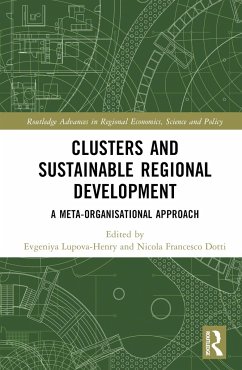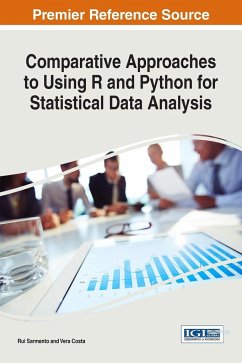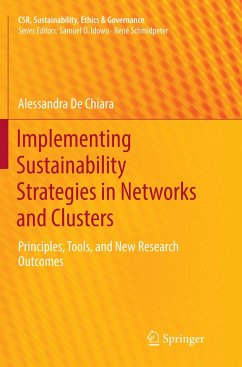
Building High-Tech Clusters
Silicon Valley and Beyond
Herausgeber: Bresnahan, Timothy; Gambardella, Alfonso
Versandkostenfrei!
Versandfertig in 1-2 Wochen
145,99 €
inkl. MwSt.

PAYBACK Punkte
73 °P sammeln!
Short description/annotationExamines how centers of industrial and technological innovation such as Silicon Valley get started.Main descriptionNational economic growth is fueled by the development of high technology clusters such as Silicon Valley. The contributors examine the founding of ten clusters that have been successful at an early stage of growth in information technology. Their key finding is that the economics of starting a cluster is very different from the positive feedback loop that sustains an established cluster. While 'nothing succeeds like success' in an established cluster, f...
Short description/annotation
Examines how centers of industrial and technological innovation such as Silicon Valley get started.
Main description
National economic growth is fueled by the development of high technology clusters such as Silicon Valley. The contributors examine the founding of ten clusters that have been successful at an early stage of growth in information technology. Their key finding is that the economics of starting a cluster is very different from the positive feedback loop that sustains an established cluster. While 'nothing succeeds like success' in an established cluster, far more difficult, risky and unlikely are the initial conditions that give rise to successful clusters. The contributors find regularities in the start of the successful clusters studied, including Silicon Valley 40 years ago. These cases contain 'old economy' factors such as competencies, firm building capabilities, managerial skills, and connection to markets, more than the flamboyant 'new economy' factors that have been highlighted in recent years.
Table of contents:
1. Introduction; 2. Learning the Silicon valley way Gordon Moore and Kevin Davis; 3. Israel's Silicon Wadi: the forces behind cluster formation Catherine de Fontenay and Erran Carmel; 4. In the footsteps of Silicon Valley(?)33; Indian and Irish software in the international division of labor Ashish Arora, Alfonso Gambardella and Salvatore Torrisi; 5. Agglomeration and growth: a study of the Cambridge hi-tech cluster Suma Athreye; 6. Clusters, competition, and 'global players' in ICT markets: the case of Scandinavia John Richards; 7. Taiwan's Hsinchu region: imitator and partner for Silicon Valley AnnaLee Saxenian; 8. The role of government in regional technology development: the effects of public venture capital and science parks Scott Wallsten; 9. Imitating Silicon Valley: regional comparisons of innovation activity based on venture capital flows Michael Horvath; 10. Conclusion, old economy imputs for new economy outcomes: what have we learned(?)33; Timothy Bresnahan and Alfonso Gambardella.
Examines how centers of industrial and technological innovation such as Silicon Valley get started.
Main description
National economic growth is fueled by the development of high technology clusters such as Silicon Valley. The contributors examine the founding of ten clusters that have been successful at an early stage of growth in information technology. Their key finding is that the economics of starting a cluster is very different from the positive feedback loop that sustains an established cluster. While 'nothing succeeds like success' in an established cluster, far more difficult, risky and unlikely are the initial conditions that give rise to successful clusters. The contributors find regularities in the start of the successful clusters studied, including Silicon Valley 40 years ago. These cases contain 'old economy' factors such as competencies, firm building capabilities, managerial skills, and connection to markets, more than the flamboyant 'new economy' factors that have been highlighted in recent years.
Table of contents:
1. Introduction; 2. Learning the Silicon valley way Gordon Moore and Kevin Davis; 3. Israel's Silicon Wadi: the forces behind cluster formation Catherine de Fontenay and Erran Carmel; 4. In the footsteps of Silicon Valley(?)33; Indian and Irish software in the international division of labor Ashish Arora, Alfonso Gambardella and Salvatore Torrisi; 5. Agglomeration and growth: a study of the Cambridge hi-tech cluster Suma Athreye; 6. Clusters, competition, and 'global players' in ICT markets: the case of Scandinavia John Richards; 7. Taiwan's Hsinchu region: imitator and partner for Silicon Valley AnnaLee Saxenian; 8. The role of government in regional technology development: the effects of public venture capital and science parks Scott Wallsten; 9. Imitating Silicon Valley: regional comparisons of innovation activity based on venture capital flows Michael Horvath; 10. Conclusion, old economy imputs for new economy outcomes: what have we learned(?)33; Timothy Bresnahan and Alfonso Gambardella.














